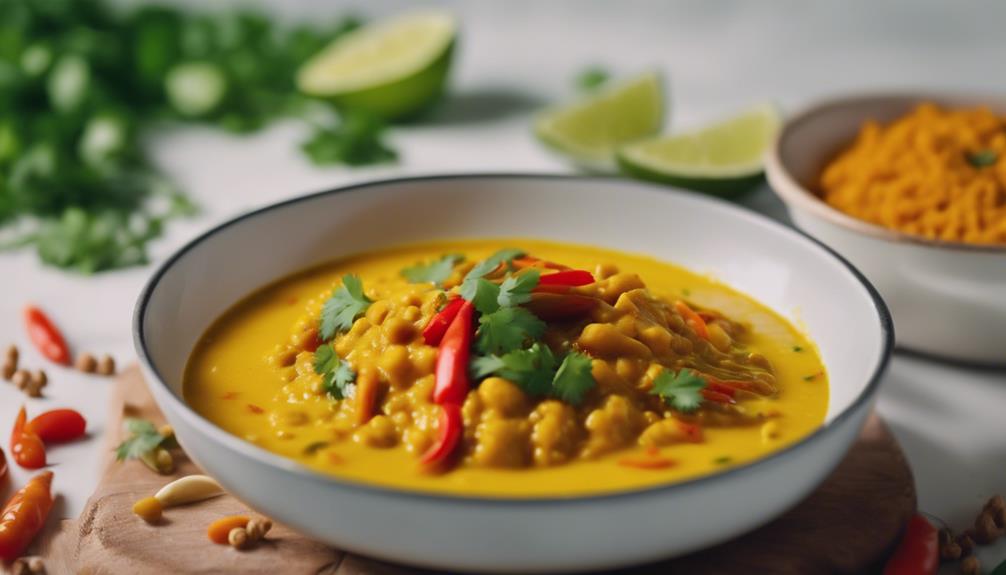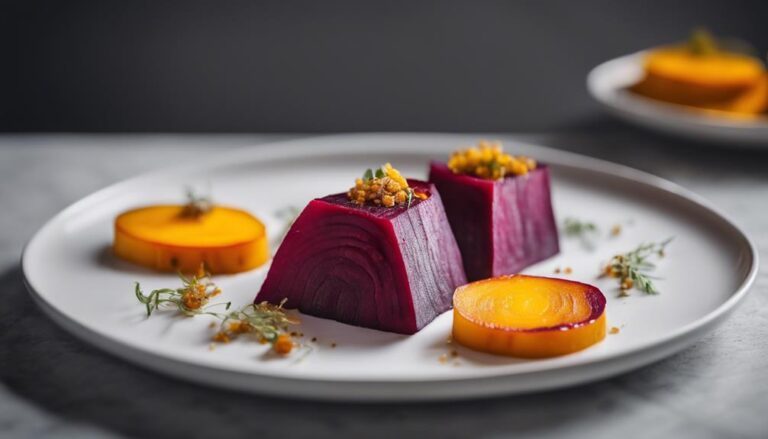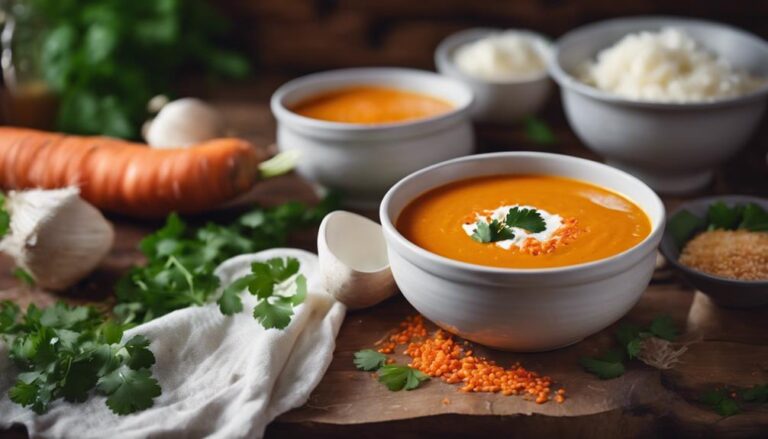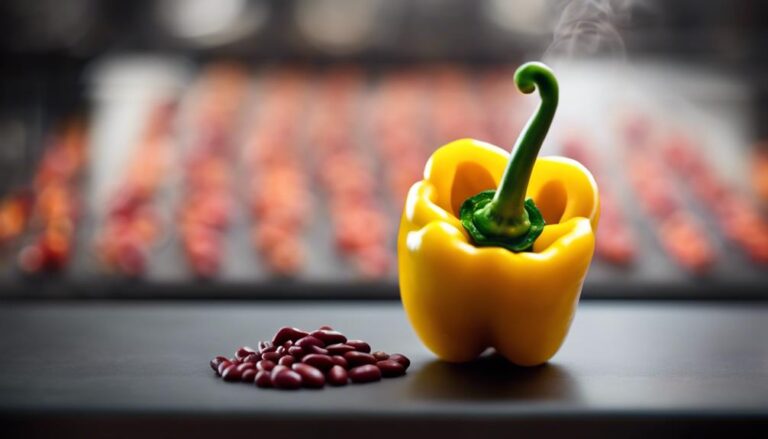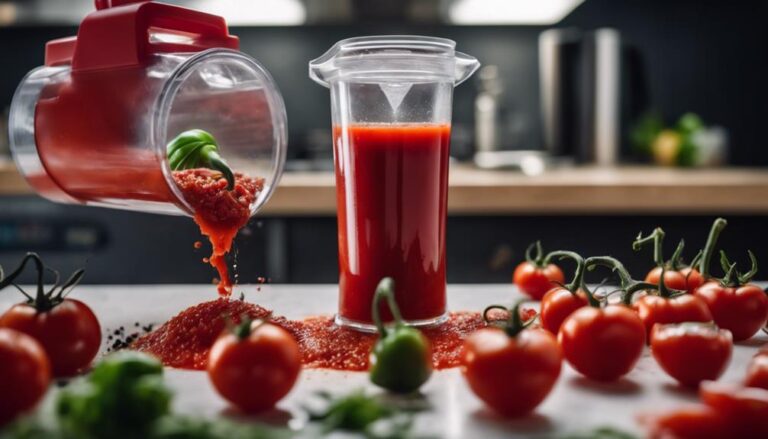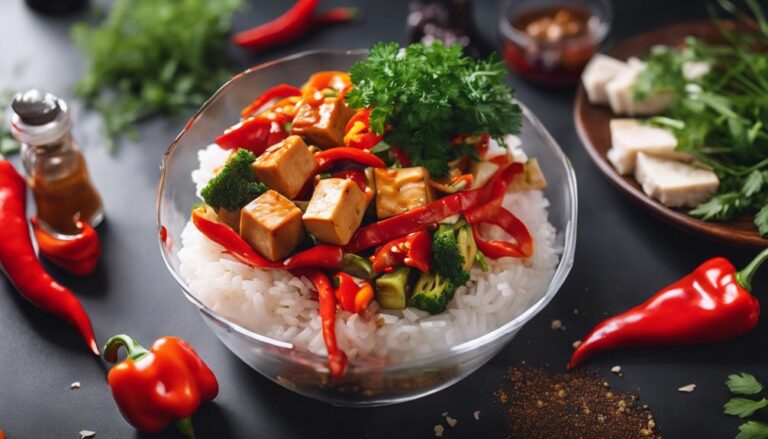Dinner Sous Vide Yellow Curry With Red Lentils
Imagine stepping into your kitchen to the warm aroma of exotic spices and hearty lentils simmering in a creamy yellow curry. The vibrant colors and tantalizing scents wafting through the air make your mouth water in anticipation of the flavors that await your taste buds. But what makes this sous vide yellow curry with red lentils truly exceptional? Stay tuned to uncover the secrets behind this delectable dish and how you can recreate it in your own culinary adventures.
What You Will Learn Here
- Sous Vide cooking ensures precise temperature control for perfectly cooked yellow curry.
- Infuse flavors consistently with sous vide, enhancing the richness of red lentils.
- Utilize aromatic ingredients strategically to enhance the depth of flavors in the curry.
- Experiment with spice pairings to create a harmonious blend of tastes in the dish.
- Layer ingredients and seasonings to build a flavorful foundation for the yellow curry with red lentils.
Culinary Origins

Curry boasts a rich history that spans various cultures and continents. It has evolved over time, adapting to local ingredients and preferences.
Today, you can find a wide array of curry varieties globally, each with its own unique blend of flavors and spices.
Curry's Historical Roots
Exploring the culinary origins of curry reveals a rich tapestry of cultural influences and diverse ingredients. Curry finds its roots in the Indian subcontinent, where it holds immense cultural significance. The word 'curry' itself is a Western creation, derived from the Tamil word 'kari,' meaning sauce.
Indian influence spread curry across the globe as trade routes expanded, leading to its integration into various cuisines worldwide.
Curry's historical roots intertwine with the complex history of the Indian subcontinent, where it was initially developed as a way to preserve and enhance food. The blend of aromatic spices like cumin, coriander, and turmeric showcases the depth of flavors that characterize curry dishes. Over time, different regions and cultures have adapted curry to suit their tastes, resulting in a vast array of variations.
Understanding curry's historical roots provides insight into the interconnectedness of global cuisine and the enduring appeal of this flavorful dish. Its evolution reflects the fusion of diverse culinary traditions, making it a beloved staple in kitchens worldwide.
Evolution of Curry
Exploring the culinary origins of curry reveals a dynamic journey of flavor evolution and cultural amalgamation. Curry, a dish that has become a staple in many cuisines worldwide, has a rich history shaped by a blend of diverse cultural influences. The evolution of curry spans centuries and continents, with each region adding its unique twist to the dish's flavor profiles.
The origins of curry can be traced back to the Indian subcontinent, where a complex blend of spices such as turmeric, cumin, and coriander created the foundation for this beloved dish. Over time, as trade routes expanded and cultures interconnected, curry spread to Southeast Asia, Africa, the Middle East, and beyond. Each region adapted the dish to suit local tastes, incorporating ingredients like coconut milk, lemongrass, and tamarind, resulting in a wide array of curry variations.
The evolution of curry showcases how culinary traditions can transcend borders, highlighting the interconnected nature of global cuisine. By exploring the cultural influences that have shaped curry, one can appreciate the depth and complexity of this beloved dish.
Global Curry Varieties
The diverse cultural influences that shaped curry's evolution have given rise to a wide array of global curry varieties, each with its unique culinary origins. Regional variations play a significant role in the development of curry, resulting in a vast spectrum of flavors and ingredients.
Indian curry, with its rich blend of spices like cumin, coriander, and turmeric, is renowned for its bold and aromatic taste. Thai curry, on the other hand, often incorporates ingredients like lemongrass, galangal, and coconut milk, creating a creamy and fragrant dish. Japanese curry is milder in comparison, with influences from British curry introduced during the Meiji era.
Caribbean curry showcases a fusion of African, Indian, and indigenous flavors, featuring ingredients like Scotch bonnet peppers and allspice. African curry varieties emphasize the use of local spices and ingredients, resulting in robust and earthy flavor profiles.
Exploring global curry varieties allows you to appreciate the diverse culinary traditions and regional nuances that have shaped these beloved dishes.
Key Curry Spices
Enhancing your yellow curry with a blend of aromatic spices will elevate the flavors of your dish to a whole new level. When preparing your curry, consider the following key spices to achieve a well-balanced and flavorful taste:
- Turmeric: This vibrant yellow spice not only gives your curry its signature color but also adds a warm and earthy flavor to the dish.
- Cumin: Known for its nutty and peppery taste, cumin is a staple in curry blends, providing a depth of flavor that complements the other spices.
- Coriander: With a citrusy and slightly sweet flavor profile, coriander lends an invigorating and aromatic note to your curry.
- Garam Masala: A traditional blend of spices like cinnamon, cardamom, and cloves, garam masala adds a warming and complex taste to your curry, combining traditional techniques with modern twists for a unique flavor profile.
Curry Recipe Variations

Explore various curry recipe variations to elevate your cooking game.
Try a unique twist with the Yellow Curry Recipe Variant, or opt for a hearty Lentil and Vegetable Curry for a comforting meal.
For a creamy and indulgent option, experiment with a Coconut Milk Infused Curry that will surely delight your taste buds.
Yellow Curry Recipe Variant
Consider experimenting with different combinations of spices to create your own unique twist on traditional yellow curry. Here are some ideas to inspire your culinary creativity:
- Curry Fusion Dishes: Blend the flavors of yellow curry with other cuisines to create exciting fusion dishes. Try incorporating Mexican, Italian, or Japanese elements into your curry for a delightful twist.
- Unique Curry Pairings: Pair your yellow curry with unexpected ingredients to elevate its taste profile. Experiment with adding fruits like pineapple or mango for a sweet and invigorating flavor or try combining it with seafood for a revitalizing twist.
- Herb and Spice Infusion: Infuse your yellow curry with fresh herbs like cilantro, basil, or mint to add a burst of freshness to the dish. Experiment with different spice levels to find your perfect balance of heat and flavor.
- Creamy Coconut Variation: Enhance the creaminess of your yellow curry by adding coconut milk or cream. This variation will bring a rich and velvety texture to your dish, perfect for those who enjoy a more indulgent curry experience.
Lentil and Vegetable Curry
To add a hearty and nutritious twist to your yellow curry repertoire, consider incorporating red lentils and a variety of vegetables for a flavorful Lentil and Vegetable Curry.
- Lentil Benefits:
Red lentils are a great source of plant-based protein, fiber, and essential nutrients like iron and folate. They add a creamy texture and earthy flavor to the curry, enhancing its richness and nutritional value.
- Flavor Combination:
The combination of red lentils with aromatic spices like turmeric, cumin, and coriander in the curry base creates a delicious harmony of flavors, making each bite satisfying and wholesome.
- Vegetable Options:
You can elevate your Lentil and Vegetable Curry by adding a mix of colorful vegetables such as bell peppers, zucchini, carrots, and spinach. These veggies not only enhance the visual appeal but also contribute different textures and flavors to the dish.
- Cooking Techniques:
To retain the nutrients and flavors of the vegetables, consider lightly sautéing them before adding them to the curry. This method helps in preserving the crunchiness and freshness of the vegetables, adding a delightful contrast to the soft lentils.
Coconut Milk Infused Curry
Enhance your yellow curry experience by infusing it with creamy coconut milk for a luscious and indulgent twist. The addition of coconut milk brings a rich and velvety texture to the curry, elevating its flavor profile with a hint of sweetness that balances the spices beautifully.
Here are some ways to make the most of this coconut milk infused curry:
- Curry Fusion Dishes: Experiment with incorporating elements from other cuisines into your coconut milk curry, such as adding lemongrass for a Thai-inspired twist or garam masala for an Indian fusion dish.
- Flavor Profiles: Play around with different herbs and spices to create unique flavor combinations. Try adding fresh basil for an invigorating note or smoked paprika for a smoky undertone.
- Coconut Milk Substitutes: If you're looking to reduce the richness of the curry, consider using light coconut milk or coconut cream as alternatives.
- Recipe Adjustments: Adjust the amount of coconut milk based on your preference for creaminess. You can also balance the sweetness by adding a splash of lime juice or a pinch of salt.
Enhancing Curry Flavors
To enhance the flavors of your curry, consider some spice pairing tips. By carefully selecting complementary spices, you can elevate the taste profile of your dish.
Ingredient layering techniques are also essential. Strategically layering ingredients helps to build depth and complexity in your curry.
Additionally, an aromatics infusion method can further enhance the flavors. Infusing aromatics at the right time adds a fragrant dimension to your dish.
Experiment with these methods to create a curry that bursts with complex and harmonious flavors.
Spice Pairing Tips
For a more flavorful curry experience, consider combining spices that complement each other well. Spice pairings play an important role in enhancing the taste profiles of your dish. When selecting spices, think about how their flavors interact with each other to create a harmonious blend. Experiment with different combinations to find the perfect balance that suits your palate.
Consider the heat levels of the spices you use in your curry. Some spices like chili powder or cayenne pepper add a fiery kick, while others like cumin or coriander offer a milder warmth. By understanding the heat levels of each spice, you can adjust the quantities to achieve the desired level of spiciness in your curry.
Additionally, pay attention to the taste profiles of the spices. For example, turmeric adds a warm, earthy flavor, while ginger brings a zesty, slightly pungent taste. Combining spices with complementary taste profiles can elevate the overall flavor of your curry to new heights.
Experimenting with different spice pairings will allow you to create a curry that's uniquely delicious and satisfying.
Ingredient Layering Technique
Consider layering your curry ingredients strategically to maximize flavor infusion and depth in each bite. By understanding different flavor profiles and cooking techniques, you can enhance the overall taste of your dish.
Start by building a solid foundation with ingredient combinations that complement each other well. For example, combining creamy coconut milk with bold spices like cumin and turmeric can create a rich and aromatic base for your curry.
Next, focus on seasoning methods to enhance the flavors further. Add salt and pepper in layers to guarantee each ingredient is well-seasoned throughout the cooking process. Additionally, consider incorporating fresh herbs like cilantro or mint towards the end to add a burst of freshness to the dish.
Experiment with different cooking techniques such as sautéing, simmering, or roasting to develop complex flavors in your curry. Each method can bring out unique tastes and textures in the ingredients, creating a harmonious blend of flavors in every spoonful.
Aromatics Infusion Method
Enhance the depth of flavors in your curry by infusing aromatic ingredients strategically throughout the cooking process. The infusion process involves adding aromatic components such as garlic, ginger, onions, and spices at different stages to extract maximum flavor.
Begin by sautéing your aromatics in oil to release their essential oils and intensify their taste. This initial step kickstarts the flavor extraction process, infusing the oil with rich, fragrant notes that will permeate the entire dish.
As your curry simmers, consider adding whole spices like cinnamon sticks, cardamom pods, or cloves to the pot. These whole spices slowly release their flavors, subtly influencing the dish without overpowering it.
Towards the end of cooking, sprinkle fresh herbs like cilantro or basil over the curry to enhance its aroma and add a pop of freshness. By strategically incorporating aromatics throughout the infusion process, you layer flavors and create a harmonious blend that elevates your curry to a new level of deliciousness.
Final Thoughts
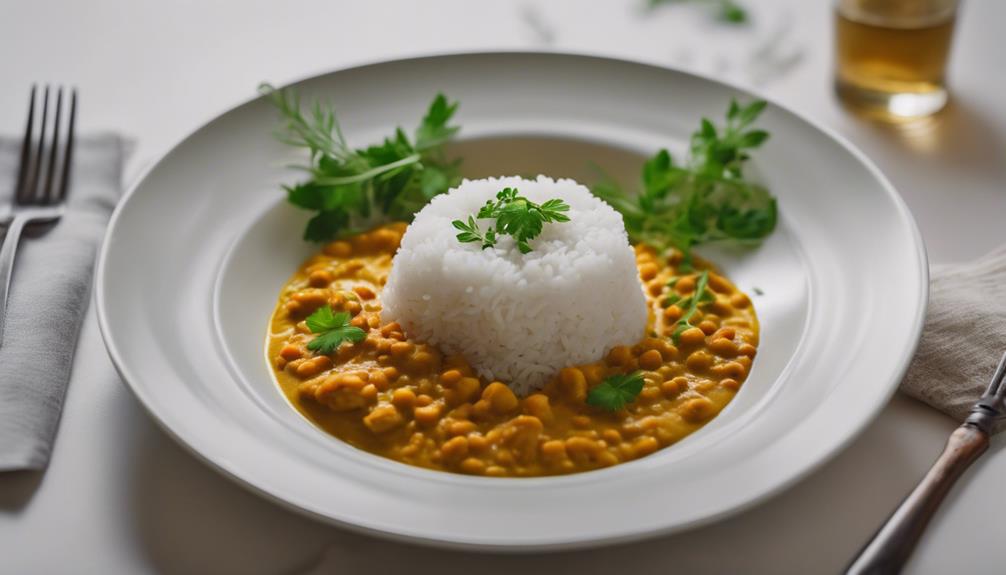
As you reflect on the enjoyable experience of preparing and savoring the Sous Vide Yellow Curry with Red Lentils, consider how this meal can become a staple in your culinary repertoire. The Sous Vide cooking technique offers benefits such as precise temperature control, ensuring perfectly cooked ingredients and enhancing the flavor profile of the dish.
Compared to traditional cooking methods, Sous Vide allows for a more consistent infusion of flavors, resulting in a harmonious blend of spices and aromatics in every bite.
The Sous Vide Yellow Curry with Red Lentils showcases how this cooking technique can elevate a classic dish to new heights. The slow cooking process intensifies the flavors, creating a rich and complex taste that lingers on your palate.
By experiencing firsthand the flavor impact of Sous Vide, you can expand your culinary skills and experiment with different ingredients and seasonings to create unique and delicious meals.
Incorporating Sous Vide cooking into your routine not only guarantees exceptional results but also opens up a world of culinary possibilities, making each meal a delightful journey for your taste buds.
Frequently Asked Questions
Can I Substitute Red Lentils With Another Type of Lentil in This Recipe?
You can substitute red lentils with other types like green or brown lentils. They may alter the dish's texture slightly but will still work well in the recipe. Adjust cooking times if needed for different lentil varieties.
Is It Necessary to Marinate the Protein Before Cooking Sous Vide?
Marinating the protein before cooking sous vide is optional. Benefits include enhanced flavor penetration, but it's not required. However, marinating can add depth to the dish, so consider giving it a try for a more flavorful outcome.
Can I Use Store-Bought Yellow Curry Paste Instead of Making It From Scratch?
Yes, you can use store-bought yellow curry paste instead of making it from scratch. It's a convenient option for ingredient variations. Adjust spice levels for flavor customization. It saves time and still adds delicious flavors to your dish.
How Do I Adjust the Spice Level of the Curry to Suit My Taste Preferences?
To adjust the spice level of your curry, try adding yogurt to cool it down or using coconut milk to mellow the heat. Choose your protein wisely; it can also impact the overall spiciness.
Can I Freeze the Leftover Curry for Future Meals?
You can freeze leftover curry for future meals. To reheat, thaw in the fridge overnight or use the microwave. This meal prep method guarantees your leftovers are utilized efficiently and saves time on busy days.
Conclusion
To sum up, dinner sous vide yellow curry with red lentils is a delectable and nutritious dish that brings together the vibrant flavors of curry spices and the hearty texture of red lentils.
The sous vide cooking method guarantees that the ingredients are perfectly infused with the rich and complex flavors, creating a satisfying meal that's both comforting and flavorful.
Try making this dish at home to experience a culinary delight that will tantalize your taste buds.
